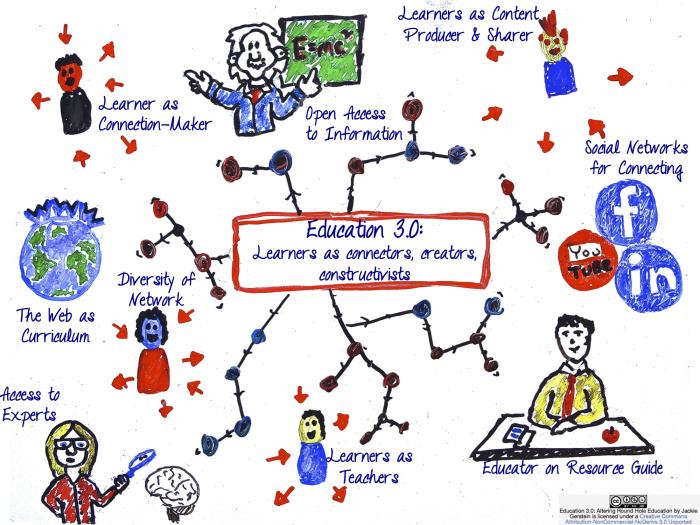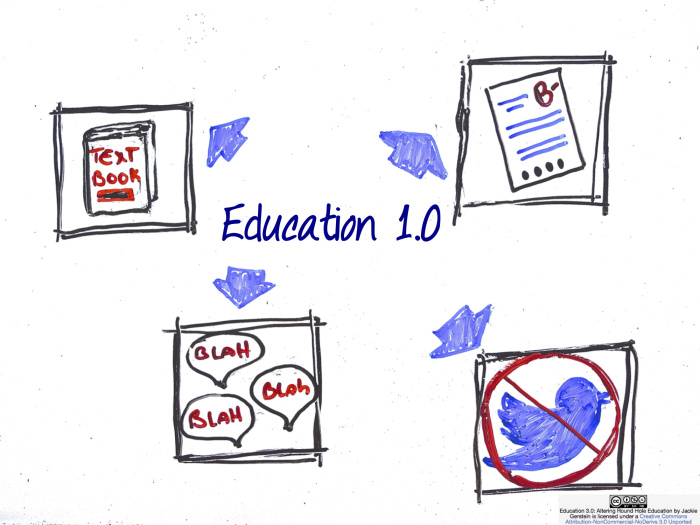As part of my journey in the “Facilitating Online Learning” subject (#EDUC90970), I continued to read more about Heutagogy – or self-determined learning. Self-determined learning is a humanist approach to teaching and learning focused on learners’ autonomy and agency during the learning process. It differs from traditional pedagogy and self-directed learning on the degree in which learners are involved in shaping their own learning experience. In self-determined learning, learners can help define their own learning objectives and assessments.
According to Blaschke and Hase (2019), self-determined learning sits on a continuum that includes Pedagogy, Andragogy (self-directed learning) and Heutagogy (self-determined learning). These different approaches vary on the level of teacher support and student autonomy. Below are four images representing their characteristics (identified as Education 1.0, 2.0 and 3.0, respectively; Gerstein, 2014):
Although for the majority of the current higher education system adopting a self-determined learning approach may seem like a distant utopia due to many constraints (e.g., large classes), it seems to be a good fit for my own teaching. I mainly teach highly autonomous and motivated higher education teachers on how to use learning analytics in their own teaching and learning (professional development workshops). However, there are some key concepts that I believe are crucial for them to be familiar with before even thinking about using learning analytics. A more traditional approach seems more appropriate for this part of the workshop.
Luckily, it’s not all or nothing when deciding what teaching and learning approach would be the best fit for our courses. We can mix and match them, according to our cohort, content and environment (Kenyon & Hase, 2013). We just need to be aware of their characteristics and counter-balance the downfalls with evidence-based instructional interventions.
For example, one of the downfalls of traditional approaches to teaching and learning is that they are not quite as motivating as in self-directed and self-determined learning experiences. While in the latter, learners’ motivation is fuelled by their autonomy and particularly freedom to pursue their own interest; in traditional approaches students mainly listen to lectures or read texts. The use of evidence-based practices to support students’ motivation can help to deal with this issue, such as using strategies to catch and hold their interest (Bolkan & Griffin, 2018).
On the other hand, one of the downfalls of self-determined learning is that many students may not be prepared to regulate their own learning in such autonomous environments (Kenyon & Hase, 2013). In this case, scaffolding (or other types of support) may be necessary to promote self-regulated learning (Dignath & Veenman, 2020).
References
Blaschke, L. M., & Hase, S. (2019). Heutagogy and digital media networks: Setting students on the path to lifelong learning. Pacific Journal of Technology Enhanced Learning, 1(1), 1-14. https://doi.org/10.24135/pjtel.v1i1.1
Bolkan, S., & Griffin, D. J. (2018). Catch and hold: Instructional interventions and their differential impact on student interest, attention, and autonomous motivation. Communication Education, 67(3), 269-286. https://doi.org/10.1080/03634523.2018.1465193
Dignath, C., & Veenman, M. V. (2020). The Role of Direct Strategy Instruction and Indirect Activation of Self-Regulated Learning—Evidence from Classroom Observation Studies. Educational Psychology Review, 1-45. https://doi-org.ezp.lib.unimelb.edu.au/10.1007/s10648-020-09534-0
Gerstein, J. (2014, December 1). Experiences in Self-Determined Learning: Moving from Education 1.0 Through Education 2.0 Towards Education 3.0 [Blog post]. https://usergeneratededucation.wordpress.com/2014/12/01/experiences-in-self-determined-learning-moving-from-education-1-0-through-education-2-0-towards-education-3-0/
Kenyon, C., & Hase, S. (2013). Heutagogy fundamentals. In S. Hase & C. Kenyon (Eds), Self-determined learning: Heutagogy in action, (pp. 7-18). Bloomsbury.





